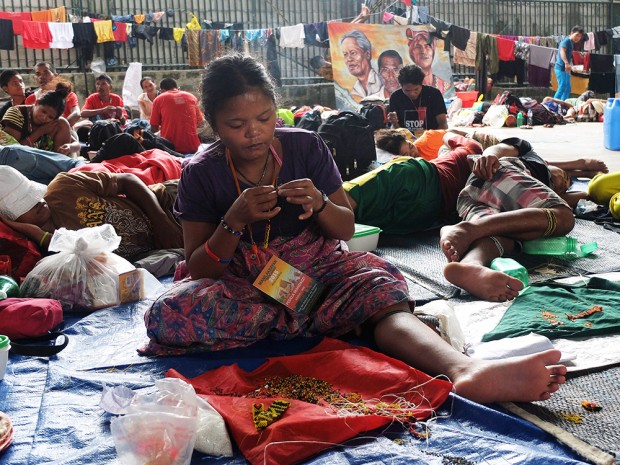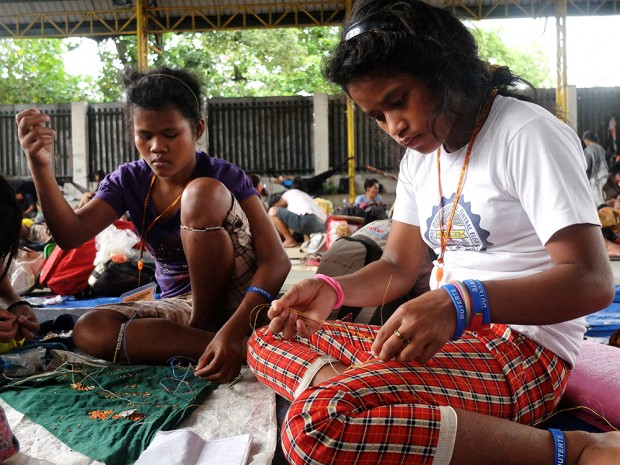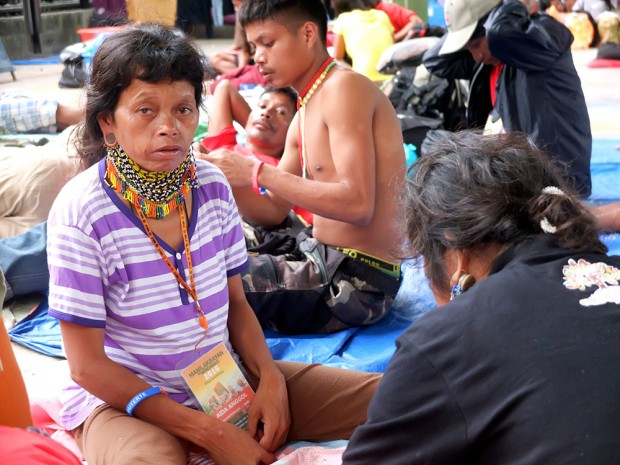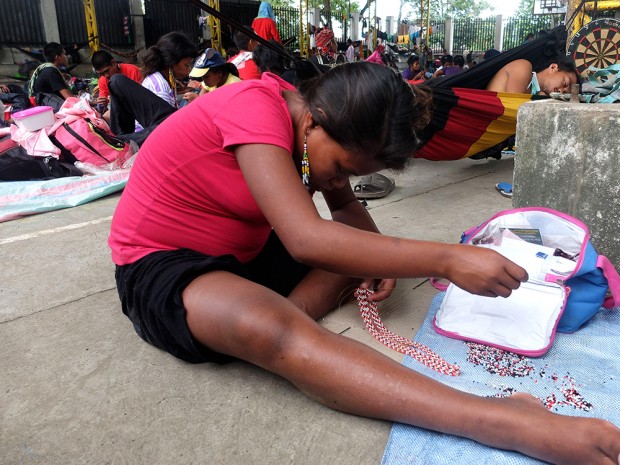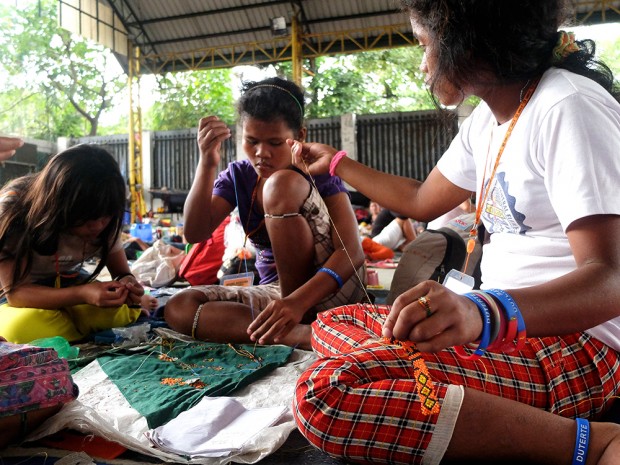Bonicris Mandagit, a Manobo bead crafter
A photo essay by Raymund B. Villanueva
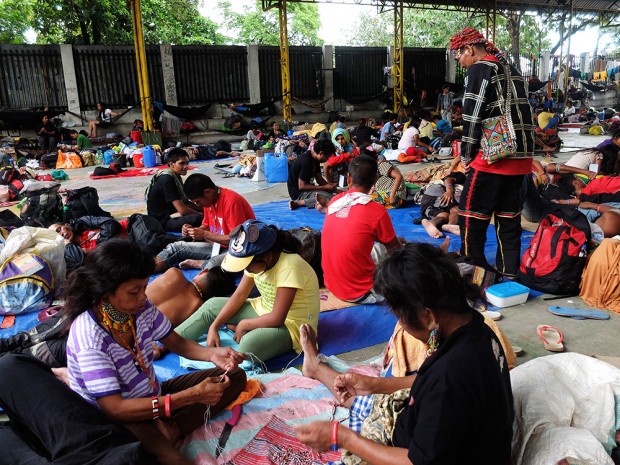
The Southern Mindanao Region contingent of Manilakbayan 2015 gathered at the covered court of Pook Dagohoy, UP Diliman last weekend.
THEY SIT AROUND in groups in a workshop of sorts on a Sunday afternoon. After more than a week on the road from Mindanao to Manila and six days in a camp within the University of the Philippines campus, they were spending the weekend on two basketball courts, regaining physical strength sapped by seemingly endless series of activities highlighting their struggle for justice, peace and the right to determine how to live in their ancestral lands. Seven hundred tired bodies either sleeping or doing beadwork.
“This is how we usually spend our free time back home, when the fields have already been planted and we wait for our crops to be harvested,” Bonicris Mandagit said. Unlike in Barangay Tibugawan, Valencia, Bukidnon where they are serenaded by chirping wild birds, a cacophony of motor traffic they still have to get used to surround what used to be a silent and near meditative activity.
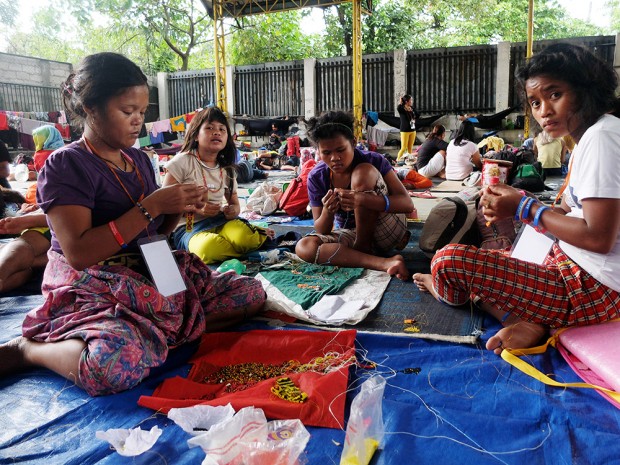
Bonbon (right), 18 years old and newly married, crafting a bracelet with a group that included her sister-in-law Pedela.
Bonbon, Bonicris’ nickname, is creating a bracelet out of the tiniest glass beads. She has already threaded the yellow and black geometric highlights and is trying to close the loop with a solid band of orange. She said she learned by observing her parents and picking up the craft when she was 10 years old. “I do not know how beading became part of our culture. I just know it is very important to us,” she said.
The Manobos have names for their most precious bead ornaments. Big necklaces that adorn Manobo women are called ginibang, beaded waistbands are called bakus, and the practical tikos are those that wrap around their lower legs to prevent varicose veins. The tangkuro, exclusive to Datus, are headdresses that have designs unique to each wearer.
Bonbon remembers when she was just allowed to wear two beadwork items. “Manobo maidens are supposed to wear only two bead ornaments. Only when we are married are we allowed to wear as many to fill our heads, necks, wrists, fingers, dresses and legs,” she explained. Bonbon wished for the time she finally could wear as many bead ornaments as she wished.
It looked like she would fulfill her wish last February when she was married. After nine days of ceremonies that involved the exchange of pigs between her family and her husband’s they were then formally considered as husband and wife. She looked forward to creating beautiful pieces for herself, especially those with lizard designs—her favorite.
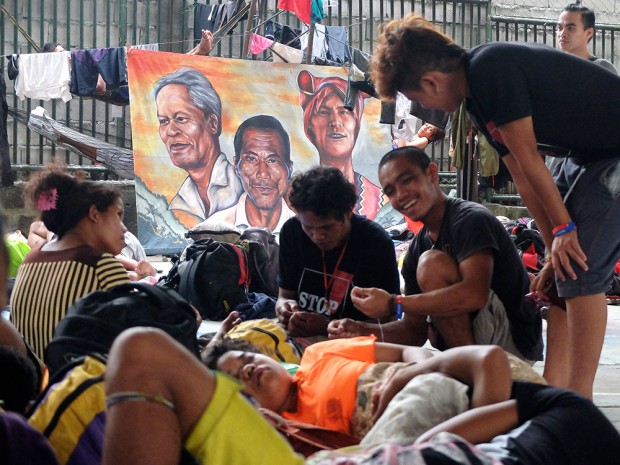
Bead-making is not exclusive to Manobo women, as even the menfolk delight in creating ornaments. On the foreground is a tikos worn by a resting Lumad.
But Philippine Army soldiers belonging to its 68th Infantry Battalion arrived and occupied the Adventist School in their community last April. The soldiers said they came to flush out the rebel New People’s Army who they say goad the Manobos into rejecting the planned pineapple, sugar cane and banana plantations to replace their farms. The soldiers told them they will kill them all if they do not leave their community.
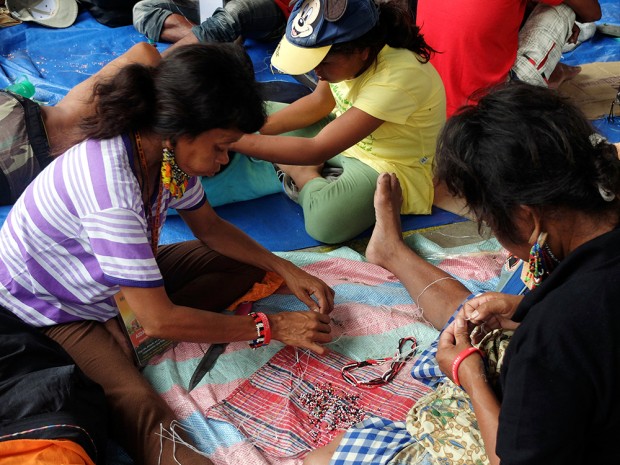
Women, men and children take part in bead-crafting sessions as much as they delight in wearing them. To the right is a Manobo male wearing cascading bead earrings anchored by wooden pegs.
Bonbon had then been married for just two months. There was no time for her to create her dream ornaments for herself.
She, her husband, and nearly a thousand others have evacuated to Davao City. They have been staying at a church compound in the past six months where they frequently receive harassments, even direct attacks from state forces and government officials.
“I actually have more time creating bead craft while in Haran and here at Manilakbayan. But these are for sale and not for me,” Bonbon said. Lumad participants sell bracelets for 100 and necklaces for 200 pesos each to visitors and supporters who visit them at their evacuation centers and campsites. “Fifty percent of the proceeds are given back to us while the rest are used to buy things we need like food and medicine,” she said.

A Manobo farmer’s thick fingers are deft enough to hold the tiny glass beads and thread them through fine strings.
Bonbon has lost count of how many beaded items she has created and sold in the last nine months they had been at Haran and during the ongoing Manilakbayan. She says beading has ceased to be just personal and cultural but has become political as well. “I am happy when I see non-Lumad wearing our beaded creations. It means they support our struggle for justice, peace and the Lumad’s right to self-determination,” she said.
Bonbon would rather that their evacuations end soon though. “I want to be a regular wife back in our community, creating beautiful bead craft for myself while waiting for our crops to be harvested,” she said. #
(Manilakbayan 2015 is now at Liwasang Bonifacio, Manila until November 22. It is open to visits from civilians who want to know more about the #StopLumadKillings and #SaveOurSchools campaigns.)

